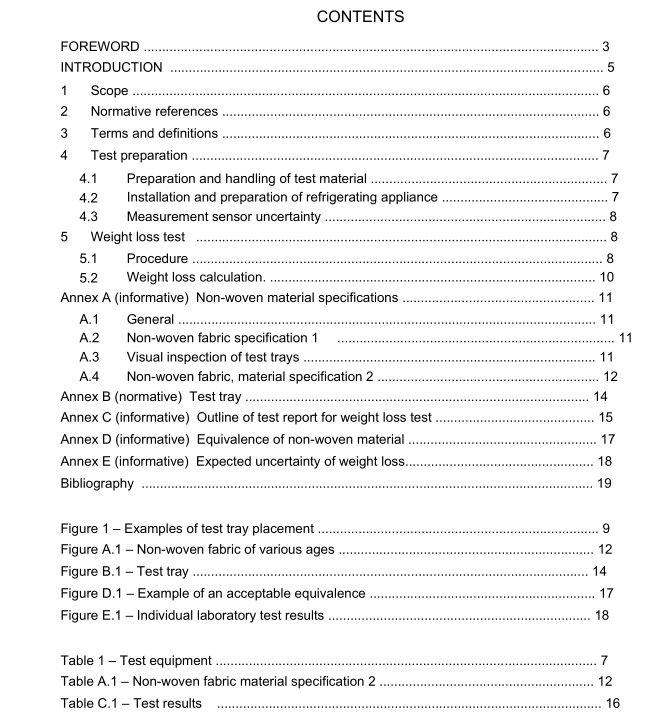IEC 63169 pdf – Electrical household and similar cooling and freezing appliances – Food preservation

IEC 63169 pdf – Electrical household and similar cooling and freezing appliances – Food preservation
1Scope
This document deals with a test to simulate the weight loss of leafy produce, given certainconditions of temperature, humidity and air movement in one or more test zones . The test canonly be applied to spaces larger than 200 mm × 150 mm ×100 mm (L × W×H).
The aim of the test is to measure the weight loss rate by measuring the weight of atest trayprior to the test and after a given duration.
NOTE Weight loss is one of the considerations for shelf life of produce.Other considerations such as condensationwill be addressed in future amendments.
2Normative references
The following documents are referred to in the text in such a way that some or all of their contentconstitutes requirements of this document. For dated references, only the edition cited applies.
For undated’references,the latest edition of the referenced document(including anyamendments) applies.
IEC 62552-1:2015, Household refrigerating appliances – Characteristics and test methods -Part 1: General requirements
IEC 62552-3:2015, Household refrigerating appliances – Characteristics and test methods -Part 3: Energy consumption and volumes
Terms and definitions
For the purposes of this document,the terms and definitions given in lEC 62552-1:2015 andthe following apply.
Iso and lEC maintain terminological databases for use in standardization at the followingaddresses:
. lEC Electropedia: available at http://www.electropedia.orgl
.lso Online browsing platform: available at http://www.iso.orglobp
3.1
test zone
space inside the refrigeration appliance subject to the
weight loss test
Note 1 to entry.: This space is typically a vegetable drawer or crisper but can also be any other compartment, sub-compartment or convenience feature (see lEC 62552-1:2015,3.3.1,3.3.2 and 3.3.3,respectively). The manufacturershall fully describe any test zones to be tested.
Note 2 to entry. Any zone in a refrigerator can be a test zone . A test zone needs to be separated or at leastpartially sealed from other zones in the same compartment or sub-compartment .
3.2
test tray
tray of specific dimensions containing a predefined number of test sheets which is chargedwith a predefined amount of water Note 1 to entry: Refer to Annex B for 3D printing files. The weight loss test uses one large 18 test sheet test tray per test zone .
3.3
weight loss
weight of water lost from the test tray between two moments in time in [g]
3.4
weight loss rate
weight loss divided by the time difference between the two moments in time expressed in [g/24h]
3.5
test sheet
sheet of the nonwoven fabric specified in Annex A cut to a size of (75 mm × 125 mm) ± 1 mm.
4 Test preparation
4.1 Preparation and handling of test material
If the test tray is not directly used after a test series, it should be stored as follows:
a) leave the test sheets inside the test tray;
b) discard the residual water from the test tray;
c) dry the test tray with the test sheets at ambient temperature and low humidity;
d) store the test tray loaded with test sheets in the fresh food compartment of a refrigerator in operation.
After storage, the test tray can be recharged with water for new tests. Annex A contains provisions for checking the quality of the non-woven fabric.
4.2 Installation and preparation of refrigerating appliance
The ambient temperature shall be 25 °C (see A.2.6, A.3.1, A.3.2 and A.4.5 of IEC 62552-1:2015).
The ambient humidity shall be in accordance with A.2.3 and A.3.6 of IEC 62552-1:2015.
The refrigerating appliance shall be installed in accordance with Annex B of IEC 62552-1:2015.
All internal accessories supplied with the refrigerating appliance shall be in their respective positions. See 5.1 in case these accessories interfere with the location of the test tray
Before the test load is added, all compartments and sub-compartments shall be empty. Their temperatures shall be determined as specified in Annex D of IEC 62552-1:2015. The appliance shall be run until steady-state conditions are observed. Where user-operated baffles or controls are provided for adjustment of temperatures in test zones, each shall be adjusted to a setting in accordance with the instructions provided. If no specific instructions are provided, the setting shall be adjusted in accordance with the target temperature listed in Table 1 of IEC 62552-3:2015 within a tolerance of ±1 K.









